Solutions For All Chapters – Science Curiosity Class 7
Electricity: Circuits and their Components
1. Choose the incorrect statement.
(i) A switch is the source of electric current in a circuit.
(ii) A switch helps to complete or break the circuit.
(iii) A switch helps us to use electricity as per our requirement.
(iv) When the switch is in ‘OFF’ position, there is an air gap between its terminals.
Answer: The incorrect statement is (i) A switch is the source of electric current in a circuit.
2. Observe Fig. 3.16. With which material connected between the ends A and B, the lamp will not glow?
Answer: The lamp will not glow if an insulator like plastic, rubber, or glass is connected between ends A and B.
3. In Fig. 3.17, if the filament of one of the lamps is broken, will the other glow? Justify your answer.
Answer: No, the other lamp will not glow.
Justification: If the filament of one lamp is broken, the circuit becomes incomplete, stopping the flow of current, and thus the second lamp cannot glow.
4. A student forgot to remove the insulator covering from the connecting wires while making a circuit. If the lamp and the cell are working properly, will the lamp glow?
Answer: No, the lamp will not glow. The insulator covering on the connecting wires prevents the electric current from flowing through the circuit, even if the lamp and cell are working properly.
5. Draw a circuit diagram for a simple torch using symbols for electric components.
Answer:
6. In Fig. 3.18:
(i) If S2 is in ‘ON’ position, S1 is in ‘OFF’ position, which lamp(s) will glow?
(ii) If S2, is in ‘OFF’ position, S1, is in ‘ON’ position, which lamp(s) will glow?
(iii) If Si; and S2, both are in ‘ON’ position, which lamp(s) will glow?
(iv) If both S1, and S2, are in ‘OFF’ position, which lamp(s) will glow?
Answer:
(i) S2 ‘ON’, St ‘OFF’: Lamp L2 will glow.
(ii) S2 ‘OFF’, St ‘ON’: Lamp L1 will glow.
(iii) S1 ‘ON’, S2 ‘ON’: Both lamps (L1 and L2) will glow.
(iv) S1 ‘OFF’, S2 ‘OFF’: Neither lamp will glow.
7. Vidyut has made the circuit as shown in Fig. 3.19. Even after closing the circuit, the lamp does not glow. What can be the possible reasons? List as many possible reasons as you can for this faulty operation. What will you do to find out why the lamp did not glow?
Answer: Reasons:
(a) Loose Connections: Ensure sill wires are securely connected to the battery, lamp, and switch.
(b) Burnt-out Bulb: Tiy replacing the bulb with a new one to see if it works.
(c) Dead Battery: Check if the battery is providing power by testing with a multimeter.
(d) Faulty Switch: Test the switch by bypassing it (connect the wires directly) to see if the lamp glows.
8. In Fig. 3.20, in which case(s) the lamp will not glow when the switch is closed?
Answer:
Case (a): The Lamp will glow.
Case (b): Lamp will not glow.
Case (c): Lamp may not glow if the battery is reversed.
Case (d): Lamps will glow.
9. Suppose the ‘+’ and ‘-‘ symbols cannot be read on a battery. Suggest a method to identify the two terminals of this battery.
Answer: To identify the positive and negative terminals of the battery:
- Take a known working LED (which has a longer wire for the positive terminal and a shorter wire for the negative terminal).
- Connect one terminal of the battery to the longer wire of the LED and the other terminal to the shorter wire using wires.
- If the LED glows, the battery terminal connected to the longer wire is the positive terminal, and the other is the negative terminal.
- If the LED does not glow, reverse the connections. When the LED glows, the terminal connected to the longer wire is positive.
10. You are given six cells marked A, B, C, D, E, and F. Some of these are working and some are not. Design an activity to identify which of them are working.
(i) List the items that you require:
Answer:
- A working incandescent lamp or LED with known polarity (longer wire for positive, shorter for negative if using an LED).
- A cell holder (optional, for easy connection).
- Connecting wires with stripped ends.
- Electrical tape (if no cell holder is available).
- A switch (optional, to control the circuit).
(ii) Write the procedure that you will follow:
Answer:
- Set up a simple circuit with a lamp (or LED), a cell holder (or wires with tape), and connecting wires. If using an LED, ensure the longer wire connects to the positive side and the shorter to the negative side of the circuit.
- Insert cell A into the cell holder (or connect it with wires), ensuring the positive terminal (metal cap) and negative terminal (flat disc) are correctly aligned with the circuit.
- Close the circuit (or turn on the switch if used) and observe if the lamp or LED glows.
- If the lamp/LED glows, cell A is working. If it does not glow, cell A is not working.
- Repeat steps 2-4 for cells B, C, D, E, and F, testing each cell one at a time.
- Record the results for each cell (working or not working).
(iii) With the items, carry out the activity to identify the cells that are working.
Answer: Follow the procedure above in a practical setup. For each cell:
- Connect the cell to the circuit.
- Check if the lamp/LED glows.
- Note down which cells (e.g., A, C, E) make the lamp/LED glow (these are working) and which do not (e.g., B, D, F, these are not working).
11. An LED requires two cells in series to glow. Tanya made the circuit as shown in Fig. 3.21. Will the lamp glow? If not, draw the wires for correct connections.
Answer: Will the lamp glow?: No, the LED will not glow because the wires are connected with the wrong polarity.
Correct Connections: Reconnect the wires so that the positive terminal of the battery connects to the longer wire of the LED, and the negative terminal of the battery connects to the shorter wire of the LED.
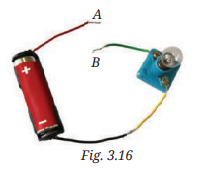
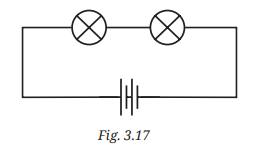
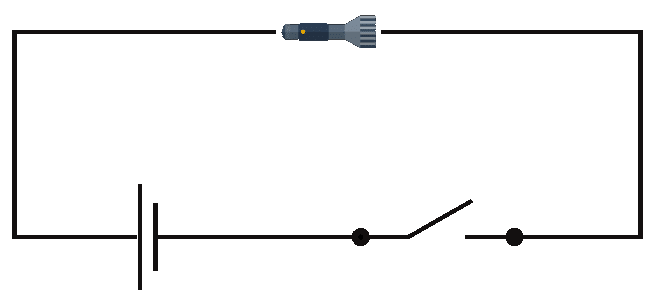
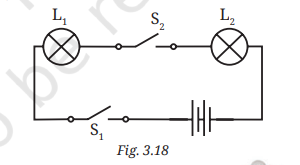

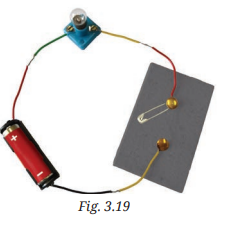
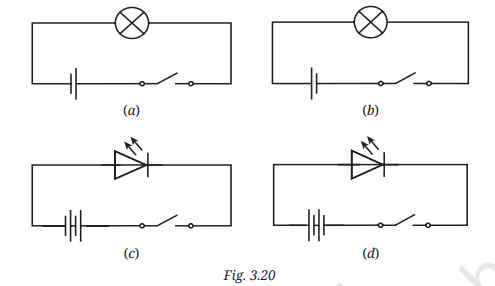
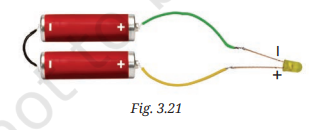

It is the world best website